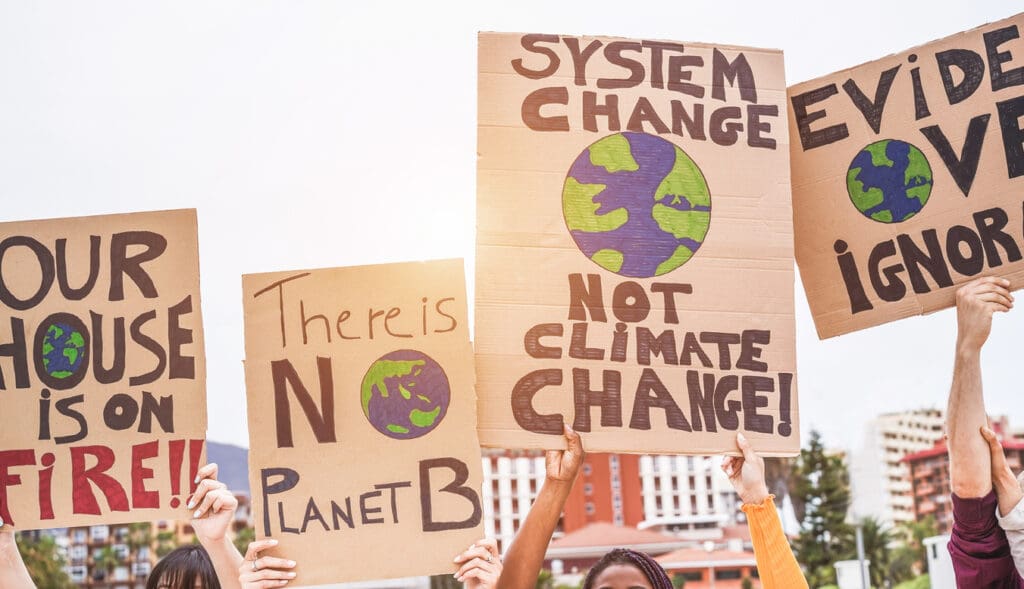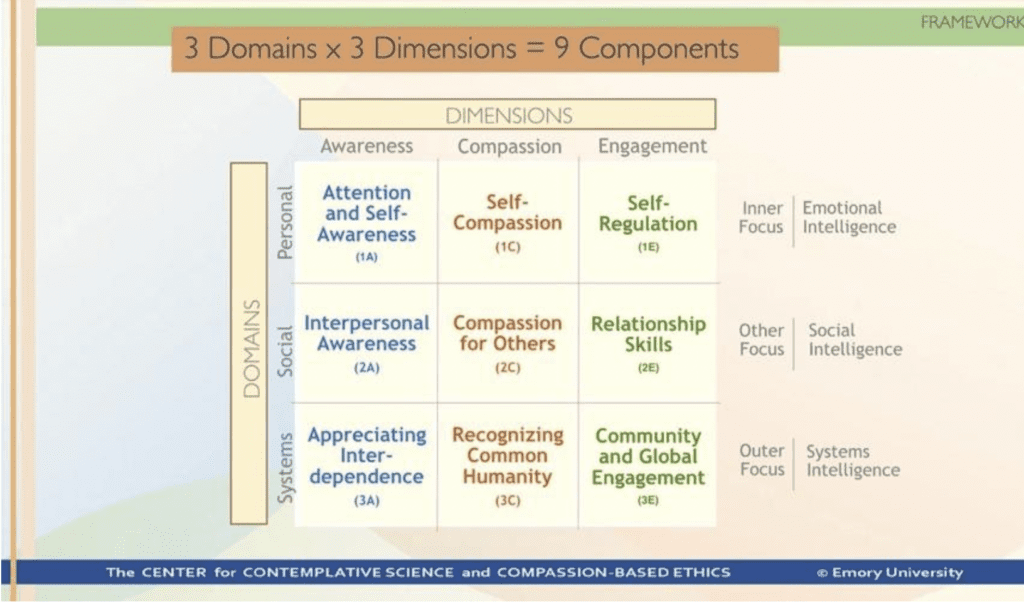
Mind & Life periodically invites guest writers to contribute their perspectives and experiences to the blog as a way of deepening dialogue and understanding around key themes related to our mission. This post is adapted from a more in-depth essay that appeared in the Autumn 2021 issue of Kosmos, A Journal of Global Transformation.
I spent five years living under the shadow of the Chevron Oil Refinery on the unceded land of the Ohlone people known as Richmond, California. In 2012, a toxic explosion sent 15,000 to the hospital, primarily people of color. Like many refinery town residents, our family moved to Richmond because it was more affordable. Experiencing oil spills and constant flaring firsthand was a pressing reminder of how systemic racism, exploitative practices, and our dominant capitalist culture are inextricably linked with our climate crisis.
There’s a saying in the climate movement that to change everything will take everyone. In my work as an educational leader of color dedicated to transforming school communities through Social and Emotional Learning (SEL), I believe it’s imperative that schools ultimately position SEL in service of a shift in collective consciousness—a shift where we truly care for each other and our planet as we work collectively and compassionately to address racial injustice and our climate crisis.
As we continue to grapple with COVID-19’s impact on mental health, schools have prioritized SEL to support the wellbeing of their staff and students. While this focus on wellbeing is critical, it is also important that SEL isn’t just a band-aid; rather SEL offers an ideal means for engaging in the deeper inner work necessary to transform our schools and society.
What is Transformative SEL?
Social and Emotional Learning (SEL) traditionally refers to the essential skills and competencies we all need for life success. These include self-awareness, goal setting, managing strong emotions, cultivating empathy, social awareness, relationship skills, problem-solving, and making healthy decisions. For years, SEL programming was thought to be race and culture neutral, but we know that nothing is race and culture neutral.
As the SEL field looks more deeply at the ways in which SEL programming can reinforce dominant-culture norms and perpetuate inequitable systems and structures, there’s growing recognition of the need for what is known as Transformative SEL. Transformative SEL engages young people and adults in powerful relationships that facilitate co-learning to examine the root causes of inequity and develop collaborative solutions that lead to personal, community, and societal well-being. According to the Collaborative for Social and Emotional Learning (CASEL), key elements of Transformative SEL include focusing SEL implementation and practice on transforming inequitable systems and promoting justice-oriented civic engagement.
Key elements of Transformative SEL include focusing
SEL implementation and practice on transforming inequitable systems
and promoting justice-oriented civic engagement.
Over the last decade, mindfulness has been increasingly incorporated into SEL programming. The organization I lead, Transformative Educational Leadership (TEL), defines mindfulness as “both a practice and a way of being with which we compassionately attend to the unfolding reality of the present moment within and without.” When we add transformative to this definition, we open our attention to include the systems—educational, social, ecological, and economic—that we are nested within. With transformative mindfulness, we strive to expand our awareness of interbeing. Interbeing is a term coined by my spiritual teacher, Thich Nhat Hanh, meaning to inter-dependently co-exist. Interbeing honors the interdependence of every person with all other persons, beings, and elements of nature. From such a perspective, we are better able to bear witness to suffering in its many forms, and act to create a more compassionate and just world through healing-centered engagement.
The Root Cause of Racial Injustice and Our Climate Crisis: A Lack of Interbeing Consciousness
Transformative SEL invites us to examine “root causes of inequity” (CASEL, 2020). For me, the root cause of inequity is not valuing all life equally, a lack of “interbeing consciousness.” Colonization, slavery, capitalism, economic exploitation, and continual extraction of the earth’s resources are built on the belief that all lives are not equal.
Until interbeing becomes a foundation for how we bring SEL into education, these approaches will still ultimately reinforce a transactional, anthropocentric way of being in the world. The moment we collectively shift toward an interbeing consciousness and live our lives with deep awareness of how we “inter-are” then it won’t be okay for anyone to live near an oil refinery, drink water with high levels of lead, or work in, let alone consume meat from, a factory farm.
One SEL program that is already incorporating a systems level component that can cultivate an interbeing consciousness is SEE Learning developed by Emory University. The emphasis on supporting students with understanding how systems interact is essential for our times.

such as the development of attention, cultivation of compassion, appreciation
of interdependence, and dialogues around ethics.
Over the last year there have been several conversations about “decolonizing SEL.” There is no real synonym for decolonization. You can’t substitute human rights or social justice for it, and for me it involves the crafting of a path forward that is rooted in the heart of indigenous cultures: kinship. Kinship involves living from a place where one is established in their relationship to each other, the universe, the land, and nature. All of life is part of one’s family, and relations are not just blood relatives. As we engage in conversations about “decolonizing SEL,” those of us who have the capacity and the will can also bring the climate dimension into these discussions so we can see our justice work as interrelated and mutually reinforcing. For me, decolonizing SEL also involves safeguarding our planet. It’s a both/and, and we need all our passion and engagement to build a diverse and powerful movement strong enough to create the world we all need and deserve.
The Role of Schools as Part of the Solution
Education systems have a vital role to play in stemming the climate crisis before it’s too late. The way that schools consume energy and food, and engage in transportation, can play a critical role in protecting our planet, especially if we think about the impact schools could have globally if every school engaged in climate action. If we prioritize advancing a more sustainable world, schools can be a critical force in addressing climate change. They can also lead the way in building more sustainable operations. The “development of collaborative solutions” (CASEL, 2020) that SEL calls for are a great opportunity to support students in engaging in climate action. Schools are part of the problem, and they also have an opportunity to be part of the solution. There’s great possibility through fusing Transformative SEL with Education for Sustainable Development which “empowers people to change the way they think and work towards a sustainable future” (UNESCO).
Dr. Martin Luther King popularized the term “Beloved Community” and infused it with deep meaning. For me, Beloved Community must also extend to the Earth. Here is some initial thinking on Transformative SEL as a Catalyst for Climate Action rooted in Education for Sustainable Development Principles, CASEL’s Five Core SEL competencies, and their Equity Focal constructs.
In the world of education, we often focus on “essential questions.” The essential question I hold deep in my heart is from Dr. Larry Ward: “What kind of ancestor do I want to be?” Just as the Seventh Generation Principle from Iroquois philosophy asks us to hold the long view of every decision and action we take, and reflect on the impact seven generations from now, this question can be a great anchor in driving how we show up daily and how we go about teaching SEL in schools. You can implement an SEL curriculum but if you are not asking yourself in each moment, “What kind of ancestor do I want to be?” your SEL won’t necessarily be transformative. As a lifelong educator I see schools as the unit of change. Let’s all seize this moment to tap into our circles of influence and bring an interbeing consciousness to the prioritization of SEL so we can evolve together and create the conditions for the paradigm shift needed by our planet and all of its inhabitants.
*****
Meena Srinivasan is the Founding Executive Director of Transformative Educational Leadership (TEL). Prior to this role, she spent five and a half years working in partnership with the Collaborative for Academic, Social and Emotional Learning (CASEL) to implement SEL system-wide in the Oakland Unified School District.
To learn more about the integration of mindfulness, ethics, and systems thinking in SEL programming, visit Mind & Life’s Education of the Heart Digital Dialogue. Summarized are presentations and discussion from Mind & Life’s 33rd Dialogue with the Dalai Lama, “Reimagining Human Flourishing.”

